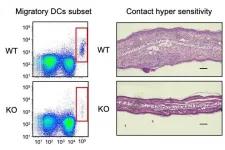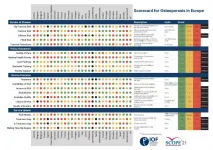The molecular underpinnings of immune cell migration
Researchers from Osaka University reveal the molecular mechanism by which immune cells migrate and reach the site of infection
2021-06-07
(Press-News.org) Osaka, Japan - In a new study, researchers from Osaka University discovered a novel molecular mechanism by which immune cells migrate to fight off infections. These findings may help in understanding the development of certain immune deficiency disorders and establish novel therapies against them.
Immune cells represent a diverse group of cells. Some circulate in the blood stream and migrate to infected tissues after receiving signals from damaged tissues. Others reside in tissues to take up the invading microbe, migrate to lymph nodes and activate an immune response. Therefore, to function effectively, the immune system's activities rely on motile cells. Immune cells move around the body via a process of repeated contraction and expansion, called actomyosin movement, involving myosin proteins. However, how this process of immune cell motility is governed remains unknown.
"As simple as it sounds, cell migration is a highly regulated and complex process," says first author of the study Takeshi Nakatani. "A lot of individual pieces of the cell have to come together to allow immune cells to move forward and travel to infected sites of the body. Lysosomes are compartments within cells that are connected to nutrient sensing and metabolism, and they have also been shown to be involved in cell motility. We wanted to understand how lysosomes regulate the process of immune cell migration."
The researchers focused on a protein complex on lysosomes, called the Ragulator complex. To understand how the Ragulator complex regulates immune cell motility, the researchers used isolated dendritic cells. These cells take up microbial invaders and bring them to other immune cells in lymph nodes to activate an immune response. The researchers found that when the Ragulator complex interacts with a protein called MPRIP (myosin phosphatase Rho-interacting protein), it prevents the protein MLCP (myosin light chain phosphatase) from blocking the phosphorylation of myosin proteins, resulting in cell contraction. In doing so, the action of the Ragulator complex can be seen as a 'brake-release'.
Interestingly, the researchers found that cells migrate by repeated cycles of protrusions of their front and contraction of their rear, leading to a forward movement. However, in the absence of the Ragulator complex, cell contraction did not occur. In experiments with animals, the researchers found that without the Ragulator complex, dendritic cells cannot travel from peripheral tissue to lymph nodes, which results in an impaired immune response.
"These are striking results that show how the lysosomal Ragulator complex is involved in the migration of immune cells in addition to its functions in cellular metabolism. Our study revealed a novel molecular mechanism by which immune cells migrate and elicit a proper immune response. These findings could help develop novel therapies against autoimmune diseases as well as better vaccines and anti-cancer drugs," says senior author of the study Hyota Takamatsu.
INFORMATION:
The article, "The lysosomal Ragulator complex plays an essential role in leukocyte trafficking by activating myosin II" was published in Nature Communications at DOI: https://doi.org/10.1038/s41467-021-23654-3
About Osaka University
Osaka University was founded in 1931 as one of the seven imperial universities of Japan and is now one of Japan's leading comprehensive universities with a broad disciplinary spectrum. This strength is coupled with a singular drive for innovation that extends throughout the scientific process, from fundamental research to the creation of applied technology with positive economic impacts. Its commitment to innovation has been recognized in Japan and around the world, being named Japan's most innovative university in 2015 (Reuters 2015 Top 100) and one of the most innovative institutions in the world in 2017 (Innovative Universities and the Nature Index Innovation 2017). Now, Osaka University is leveraging its role as a Designated National University Corporation selected by the Ministry of Education, Culture, Sports, Science and Technology to contribute to innovation for human welfare, sustainable development of society, and social transformation.
Website: https://resou.osaka-u.ac.jp/en
[Attachments] See images for this press release:

ELSE PRESS RELEASES FROM THIS DATE:
2021-06-07
June 7, 2021 - Nyon, Switzerland -- A new report by the International Osteoporosis Foundation (IOF) draws attention to the burden of osteoporosis and the gaps and inequalities in the provision of primary and secondary prevention of fractures due to osteoporosis across Europe. 'SCOPE 2021: a new scorecard for osteoporosis in Europe' provides detailed findings for the 27 countries of the European Union as well as Switzerland and the United Kingdom (referred to as 'EU27+2'), covering key indicators for four domains: burden of disease, policy framework, service provision and service uptake.
Professor John A. Kanis, IOF Honorary President and lead author of SCOPE, stated:
"Osteoporosis is a major concern in Europe as it results in 4.3 million fragility fractures and health ...
2021-06-07
Scientists have established the most reliable estimates to date of past temperature variations in Antarctica.
They highlight significant differences in behaviour between West and East Antarctica.
This study makes it possible to test and consolidate future climate projections.
Antarctica has experienced significant temperature changes, especially since the last glacial period. An international collaboration including scientists from the CNRS1 has now challenged previously accepted estimates of these variations, using new measurements published on June 4, 2021 in Science. Their study highlights differences in behaviour between East and West Antarctica, connected in particular ...
2021-06-07
New research identified a novel interaction between the SARS-CoV-2 spike protein and the galectin-3-binding protein (LGALS3BP) which could be a new therapeutic anti-viral target. The research also found the presence of detectable viral RNA in blood in COVID-19 patients is a strong predictor of mortality.
The paper, published today in Nature Communications, was led by a group of researchers from King's College London, Guy's and St Thomas' NHS Foundation Trust and King's British Heart Foundation Centre. The research was funded by the NIHR Guy's and St Thomas' Biomedical Research Centre and supported by grants from BHF.
In the study, authors analysed close to 500 blood samples from patients ...
2021-06-07
Cows can pass on the hypoglycin A toxin through their milk, a study by the Martin Luther University Halle-Wittenberg (MLU) and the Leibniz Institute of Plant Biochemistry (IPB) in Toxins shows. The substance can cause severe symptoms in humans and animals. Small amounts of the toxin were detected in the raw milk of cows that grazed in a pasture exposed to sycamore maple. The team calls for further investigations to realistically assess the potential dangers.
High concentrations of hypoglycin A can be found in unripe akee and lychee fruit and in the seeds and seedlings of various maple trees. These include, for example, the sycamore maple, which is common throughout Europe. The toxin can cause severe illness in humans. In 2017, a team of researchers in India ...
2021-06-07
Travellers abroad may pick up bacteria and other vectors containing genes conferring antimicrobial resistance which remain in the gut when returning to their home country, according to a study published in Genome Medicine.
A team of researchers at Washington University, USA and Maastricht University, Netherlands investigated the presence of antimicrobial resistance (AMR) genes in the human gut microbiome by analysing the faecal samples of 190 Dutch travellers before and after travel to destinations in Northern Africa, Eastern Africa, Southern Asia ...
2021-06-07
RApid DIgital Crispr Approach (RADICA) is a molecular rapid testing methodology that allows absolute quantification of viral nucleic acids in 40-60 minutes.
RADICA is four times faster and significantly less expensive than conventional polymerase chain reaction (PCR) methods as it does not require costly equipment for precise temperature control and cycling.
Method has been tested on SARS-CoV-2 synthetic DNA and RNA, Epstein-Barr virus in human B cells and serum, and can be easily adapted to detect other kinds of viruses.
Singapore, 7 June 2021 - Researchers from Critical Analytics for Manufacturing Personalized-Medicine (CAMP), an Interdisciplinary Research Group (IRG) at the Singapore-MIT ...
2021-06-07
Nanoclusters, which consist of several or even thousands of atoms, represent an important intermediate state between microscopic atoms and macroscopic matter. A profound comprehension of the composition, structure, and properties of nanoclusters is crucial for exploring or extending their functional applications. Among the numerous types of nanoclusters, metal chalcogenide supertetrahedral clusters (MCSCs) have attracted great attention since the 1980s for their uniform sizes, well-defined structures, and semiconductor properties. Notably, because ...
2021-06-07
Russian paleontologists discovered the skull of a Pleistocene small cave bear with artificial damage in the Imanay Cave (Bashkiria, Russia). A bear aged 9-10 years was killed with a spear during hibernation about 35 thousand years ago. If the assumptions of scientists are confirmed, the find will become the world's first direct evidence of a Paleolithic man hunting for a small cave bear. The description of the skull was published in the Vestnik Archeologii, Anthropologii I Ethnographii.
"The hole in the skull could be either natural or artificial," said senior researcher of the laboratories at the Ural Branch of the Russian Academy of Sciences and ...
2021-06-07
Measurement postulate is crucial to quantum mechanics. If we measure a quantum system, we can only get one of the eigenvalues of the measured observable, such as position, energy and so on, with a probability. Immediately after the measurement, the system will collapse into the corresponding eigenstate instantly, known as state collapse. It is argued that the non-cloning theorem is actually a result of the measurement postulate, because non-cloning theorem would also hold in classical physics. The possibility of cloning in classical physics is actually the ability to fully measure a classical system, ...
2021-06-07
Various forms of complex multicellular organisms have evolved on Earth, ranging from simple Volvox carterii which possess only 2 cell- types to us humans with more than 200 cell types. All originate from a single celled zygote, and their developmental processes depend on switch-like gene regulation. These processes have been studied in great detail within a few model organisms such as the worm C. elegans, and the fruit fly D. melanogaster. It is also known that the key molecules and mechanisms that are involved in the development of multicellular organisms are highly conserved across species.
What is also remarkable is that only a handful of molecules and mechanisms that go into the development of a multicellular organism can generate such a ...
LAST 30 PRESS RELEASES:
[Press-News.org] The molecular underpinnings of immune cell migration
Researchers from Osaka University reveal the molecular mechanism by which immune cells migrate and reach the site of infection







